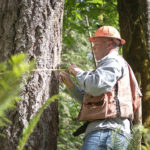Forestry 101: How current forest practices impact the future for the better
Posted: November 5, 2018Source: The Seattle Times By Washington Forest Protection Association

Called both a science and an art by those in the profession, silviculture is the practice of growing, managing and protecting healthy and sustainable forests.
While growing trees may seem straightforward at first glance, sustainable forestry practices are actually very complex and require patience, foresight and maintaining close attention to the entire landscape – not only the trees growing on it. In addition to taking inventory of mature timber and growing stock, identifying stands and putting infrastructure in place, foresters also adhere to strict forest practice rules, regulations and best management practices.
Beyond just trees, good forest practices are also concerned with wildlife, soils, water, insects and people. Sustainable forestry has far-reaching benefits and impact, chief among them clean water for fish and wildlife, clean air to breathe and healthy ecosystems.
Work is being done by private and state forestland managers to improve road systems and remove barriers to fish migration, and setting aside uncut buffer zones along streams to keep water cool and clear. Forestlands are critical to clean air – the trees sequester carbon dioxide, a greenhouse gas linked to climate change. Wood products store carbon during their useful life. And healthy forest landscapes help manage the occurrence of catastrophic wildfires, as well as offering habitat for wildlife.
Sustainable forestry is cyclical, with repeating harvests and replanting efforts constantly going on. In Washington state, private forest landowners generally replant trees in the 12 to 18 months following a harvest. On average, there are three trees planted for every one that is harvested, and more than 85 percent of these seedlings survive and grow.
The 12- to 18-month cycle from harvest to replanting is significantly quicker than the 36-month time frame than Washington state’s Forest Practice Act requires. This promotes faster tree growth so landowners can produce the products that we all use every day. Each year, forest landowners plant more than 52 million tree seedlings in harvested areas. Washington state is the second-largest softwood lumber producer in the nation. The wood is used mainly to build homes and for remodeling. Nearly 70 percent of Washington state’s timber harvest in 2017 came from privately owned forests and tree farms.
Current forestry practices utilize science-based research to continually improve the management process. Foresters employ a variety of scientists, including hydrologists, wildlife biologists, geomorphologists and dendrologists. These are experts in a range of disciplines — silviculture, wildlife, soils, geology, disease, tree physiology — as well as in all aspects of forest management and harvesting.
Healthy forests are more resistant to damage from insects, disease, wildlife and catastrophic wildfires. Furthering our knowledge of sustainable and responsible forestry practices is critical, now more than ever. Because forests and wood products are pivotal in reducing carbon dioxide in the atmosphere, sustainable forestry which produces wood products that store carbon will be a pivotal strategy in reducing global warming.
The Washington Forest Protection Association is a trade association representing private forest landowners in Washington State. Members are large and small companies, individuals and families who grow, harvest and re-grow trees on about 4 million acres.

